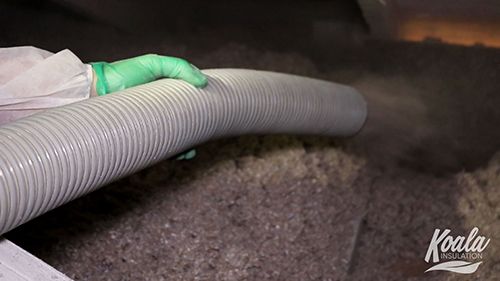Are you tired of feeling drafts in your home, struggling to control the temperature through extreme weather, or paying excessive heating and cooling bills? The solution may be in your walls: blown-in insulation. When installed properly, blown-in insulation is one of the best ways to improve your home’s energy efficiency and comfort while also saving you money long-term. Read on to understand more about benefits of blown in insulation over traditional batt insulation, and whether it’s an effective solution for your home.
How Does Blown-In Insulation Work?
Blown-in insulation is a loose-fill insulation made from fiberglass, cellulose (recycled paper), or mineral (rock or slag) wool. Small pieces of these materials are pneumatically applied into wall cavities and attics through holes drilled by installers. The loose pieces settle into any nooks and crannies, sealing air leaks wherever they exist in your framing. The insulation fills all available space evenly and densely for greater coverage and energy efficiency.
Blown-in insulation is also highly versatile. It can be retrofitted into existing homes through virtually invisible holes that are patched and painted over. Because it’s a loose-fill, blown-in insulation can easily mold into oddly-shaped corners or around obstacles. The finished product forms an air-tight, inert barrier that prevents conditioned air from escaping outside.
Benefits Over Traditional Batt Insulation
Blown-in insulation offers several notable advantages over traditional fiberglass batts or rigid foam panels:
- Better coverage and air sealing. Gaps often remain between batts, allowing air to leak through like an open window. Blown-in insulation leaves virtually no empty spaces. It seals air leaks and creates a more consistent, protective barrier.
- Easier installation and retrofitting. Blown-in insulation can be installed in new construction or existing homes. Dense pack cellulose makes it highly useful for retrofitting homes without doing damage.
- Cost-effective. Because it requires less labor to install, and fills every joist cavity completely, blown-in insulation typically provides a lower cost-per-square-foot than traditional batts. More coverage for less money!
- Longer lifespan. Blown-in insulation materials don’t sag or shift out of place over time like batts sometimes do. They remain evenly embedded in place for longer performance that requires minimal servicing.
Energy Savings and Environmental Benefits
So how exactly can blown-in insulation help you save? A 2017 study by specialists at EnergyStar found that adding proper insulation and air sealing can save homeowners up to 20% on monthly heating and cooling costs. Blown-in insulation is one of the best options you can choose to yield these types of savings. In fact, in one case study, a family cut their $1,000 per year energy bills nearly in half by adding blown-in insulation to their 1970s home!
Additionally, blown-in insulation reduces your home’s carbon footprint while enhancing efficiency. Much of the material is fiberglass or made from recycled paper or other reused waste products. Less energy spent heating and cooling your home results in lower greenhouse gas emissions in your community. Insulation also prevents heat from transferring out of the house during colder months. This means your home furnace doesn’t need to work as hard, saving electricity and gas consequently.
Types of Blown-In Insulation
Cellulose: The most popular and affordable option made from recycled newspaper. It provides great coverage at 3.5 R-value per inch of thickness. Cellulose stops airflow effectively, good for retrofits. May settle over time so requires occasional “topping off”.
Fiberglass: Classic fluffy insulation which blankets interior wall space with ease. It has an R-value of 3 per inch but contains formaldehyde so requires respirators and protective gear for installation. Less effective at stopping airflow than cellulose.
Mineral Wool: Made from molten rock or steel production waste, mineral wool insulation is fire resistant and works in hot, humid climates. It has an R-value around 3.5 per inch. However, it’s expensive and particles can irritate eyes and skin during installation.
Spray Foam: This is applied as a liquid that expands into crevices to function as both insulation and air sealant. With the highest R-value around 7 per inch, spray foam is the premium option. However, material and installation costs are comparatively very high for spray foam insulation.
Before selecting insulation, consult with energy efficiency experts to determine recommended R-values for your region and specific climate conditions. They can also help you consider by blown-in insulation type, required coverage, and projected return on investment. Get multiple quotes from experienced installers as well. With the right insulation and quality professional installation, you’ll be much more comfortable in your home and save hundreds per year without sacrificing comfort one bit!
Conclusion
Blown-in insulation is an extremely effective, affordable way to insulate both existing and newly constructed homes. It outperforms traditional batt insulation when it comes to energy savings, air sealing properties, coverage, installation costs, and durability. While certain types of blown-in insulation come with specific advantages, cellulose and fiberglass remain the most commonly used and readily available materials. Investing in quality blown-in insulation with an R-value recommended for your area can lower heating/cooling bills dramatically while making indoor living much more enjoyable through all seasons. Consult regional climate and building specialists to select the perfect insulation for your space and budget.


